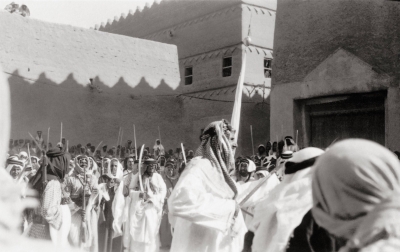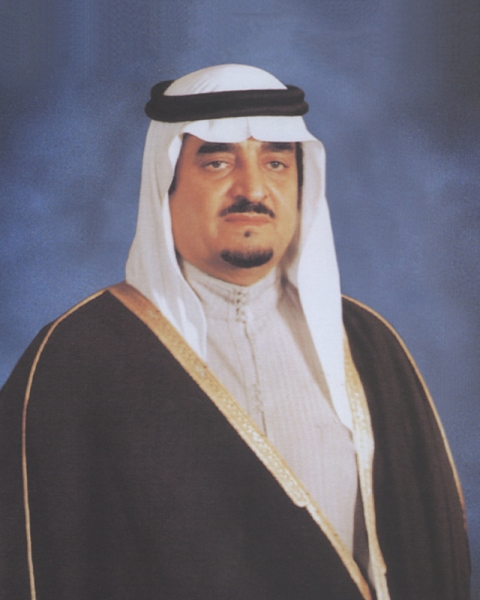
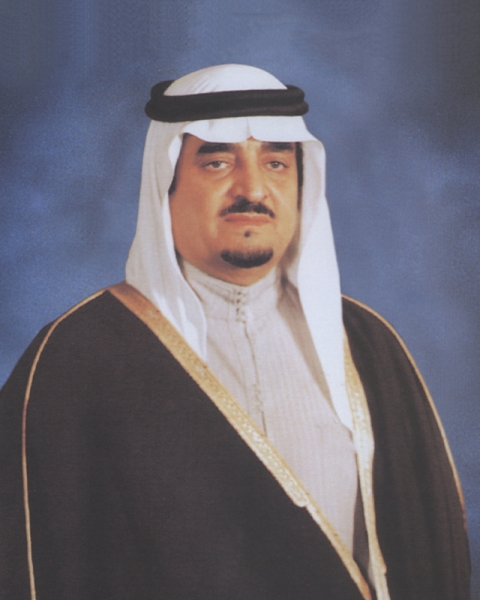
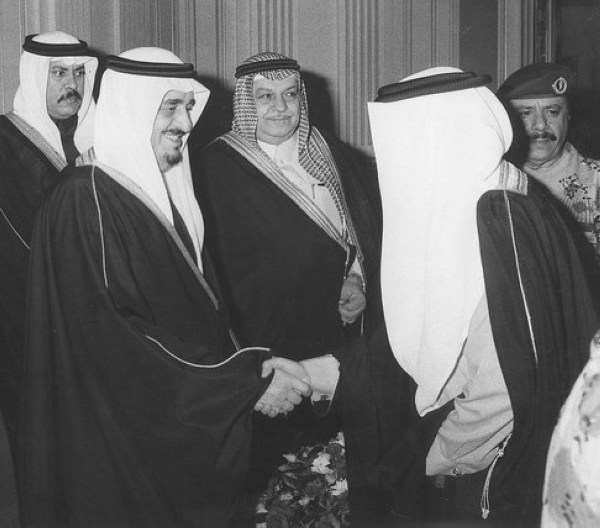
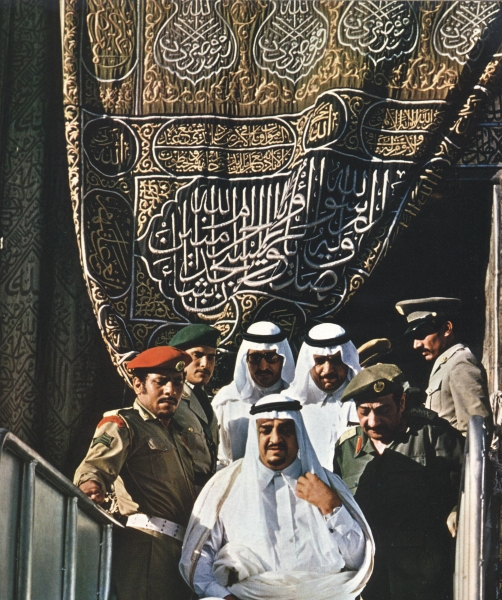
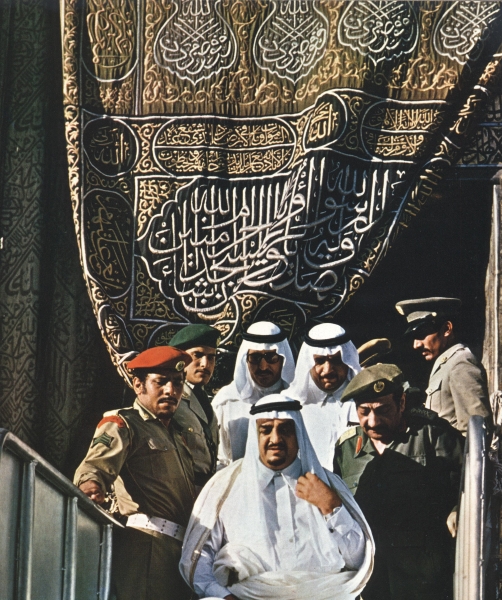
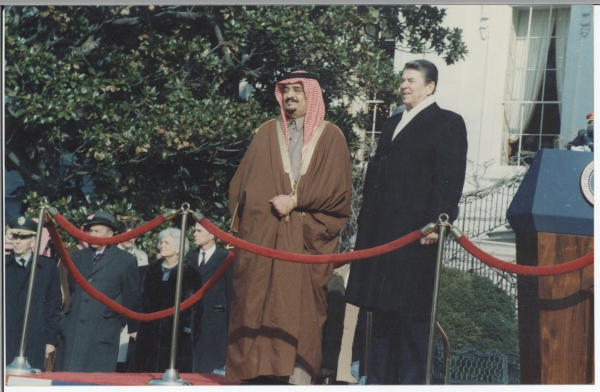
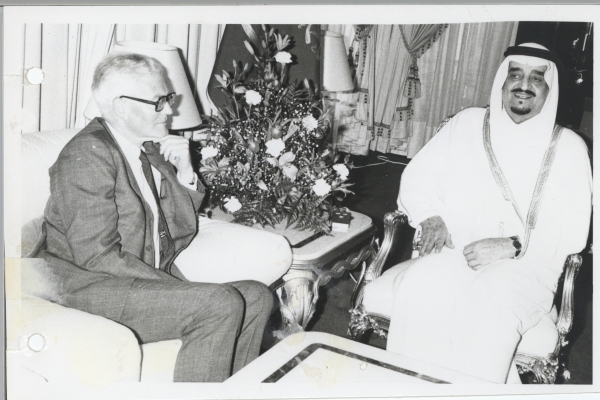
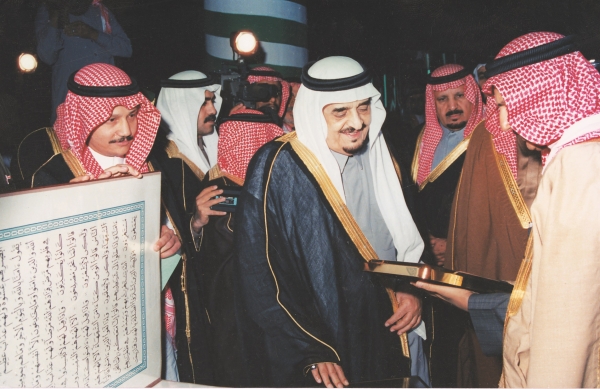
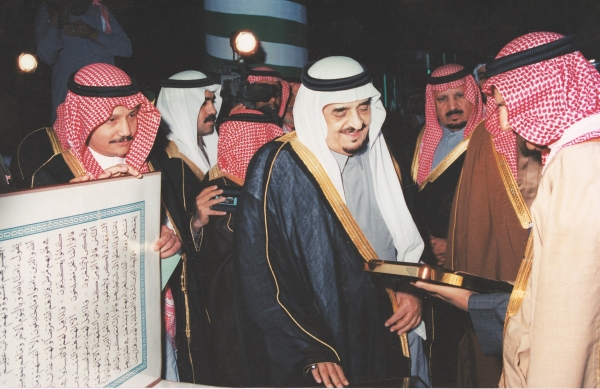
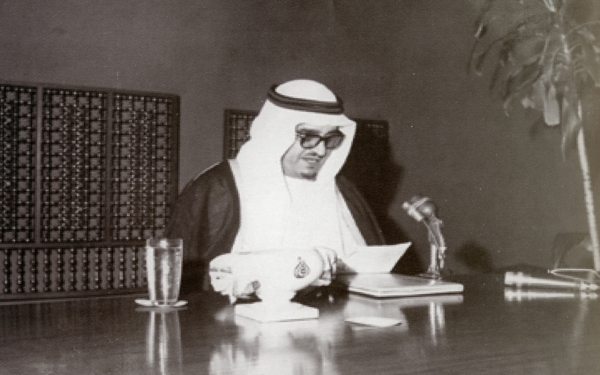
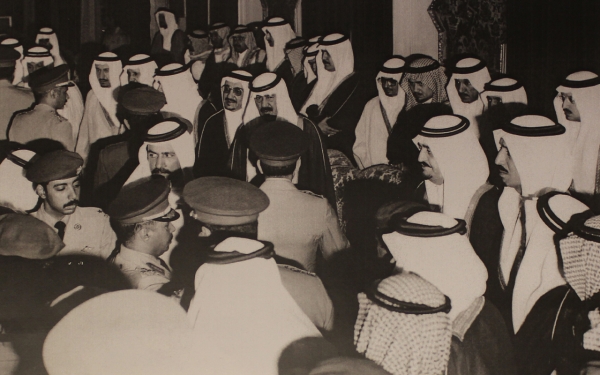
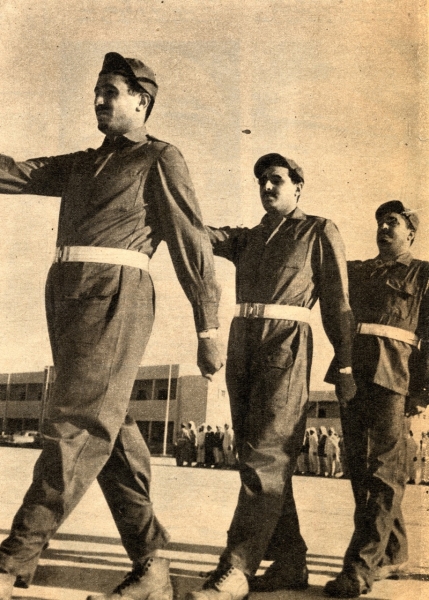
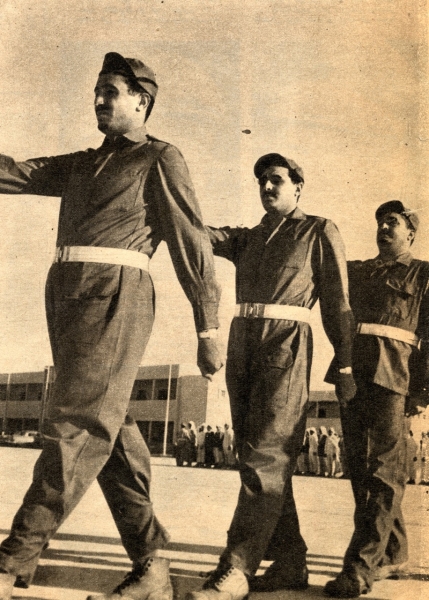
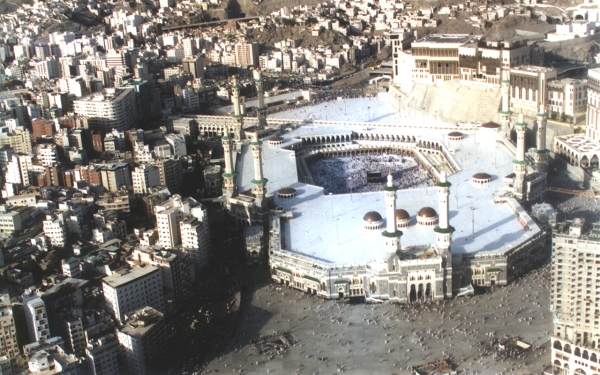

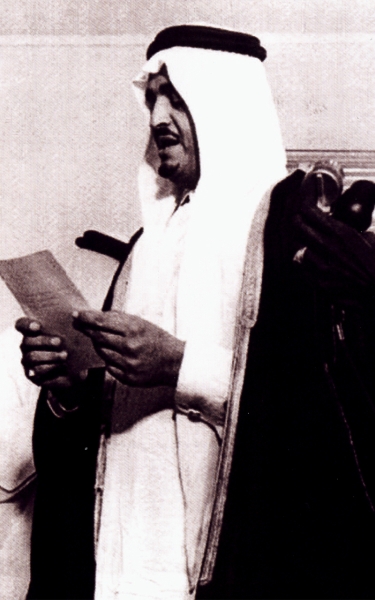
King Fahd Bin Abdulaziz Al Saud (1921-2005), was the fifth king of the Kingdom of Saudi Arabia, following his father King Abdulaziz, and his brothers Saud, Faisal, and Khalid. He was the first to be titled the Custodian of the Two Holy Mosques. He ruled Saudi Arabia for twenty-four years, starting in 1982, after his brother King Khalid, and ending in 2005. He was succeeded by his Crown Prince, King Abdullah Bin Abdulaziz.
King Fahd Bin Abdulaziz
He is Fahd Bin Abdulaziz Bin Abdulrahman Bin Faisal Bin Turki Bin Abdullah Bin Mohammed Bin Saud Bin Mohammed Bin Muqrin Bin Markhan Bin Ibrahim Bin Musa Bin Rabi'ah Bin Mani' al-Muraydi from Banu Hanifah, from Bakr Bin Wail, from Rabi'ah Bin Nizar, from Ma'ad Bin Adnan.
He is the ninth son of the Founding King, his mother Princess Hessa Bint Ahmed al-Sudairi. His ancestors resided in the city of Diriyah, which was founded by Mani' al-Muraydi, the ancestor of the Al Saud family.
King Fahd's birth and upbringing
King Fahd was born in 1921 in Riyadh City, in al-Hukm Palace, which was renovated by the Founding King Abdulaziz, in 1910. His birth period was a time when King Abdulaziz was working on unifying the Saudi entity and annexing regions of the Arabian Peninsula under his rule, marking the beginning of security, peace, and national unity, specifically when his father managed to annex the last region in Najd to his rule, followed by successive victories in the decisive unification battles. When he reached the age of eleven, the unification of the Arabian Peninsula was declared under the name of the Kingdom of Saudi Arabia, and his father was named king over it.
King Fahd's educational journey
King Fahd Bin Abdulaziz joined his first educational phase at the age of six at the Palace School, a school established on the upper floor next to the offices of King Abdulaziz. It consists of a spacious room whose roof is supported by three pillars. It is different from the old school that was established at the end of al-Dirah Palace to the west, next to the palace's storerooms, and located on the ground floor of the palace. The first generation of King Abdulaziz's sons were educated there: Prince Mohammed, King Khalid, Prince Saad, Prince Nasser, and Prince Abdullah, along with a number of princes and some followers. A teacher who was skilled in the arts of teaching, calligraphy, and the popular arts of the time, named 'Mohammed al-Hasawi' from Riyadh, taught there. He was called 'al-Hasawi' due to his frequent visits and travels to al-Ahsa and the Gulf countries, in addition to being one of the teachers at the first school alongside Mohammed Bin Akif and Abdulrahman Bin Akif.
Then, in 1935, King Abdulaziz ordered the establishment of the Princes' School in the palace and entrusted its affairs to teachers Ahmad al-Arabi and Hamed al-Habes. In 1937, the management of that school was assigned to 'Abdullah Khayat', who selected a number of teachers, including 'Ahmad Ali al-Kazemi' and 'Saleh Khozami'. King Abdulaziz himself welcomed them at the opening of the school under its new system and conveyed to them his wishes for the education of his sons, emphasizing that above all, he wanted a focus on the Holy Quran and writing, followed by the rest of the lessons.
In his youth, King Fahd moved to the Saudi Scientific Institute, a facility founded by King Abdulaziz in Makkah al-Mukarramah in 1925, following his annexation of the Hejaz to the remaining parts of Saudi Arabia. The institute was established with the purpose of fulfilling the primary schools' need for qualified teachers. It was the first Saudi educational institution to graduate a number of individuals who played a significant role in the development of education in Saudi Arabia thereafter. The opening of this institute was announced in the official gazette in 1926. This institute included night sections for employees whose work circumstances did not allow them to continue their studies during the day. The curriculum of this institute included the study of the Holy Quran and Tajweed, lessons in creed, dictation, arithmetic, reading and conversation, composition, Arabic grammar rules, public speaking, geography, ethics, and the natural sciences, among others.
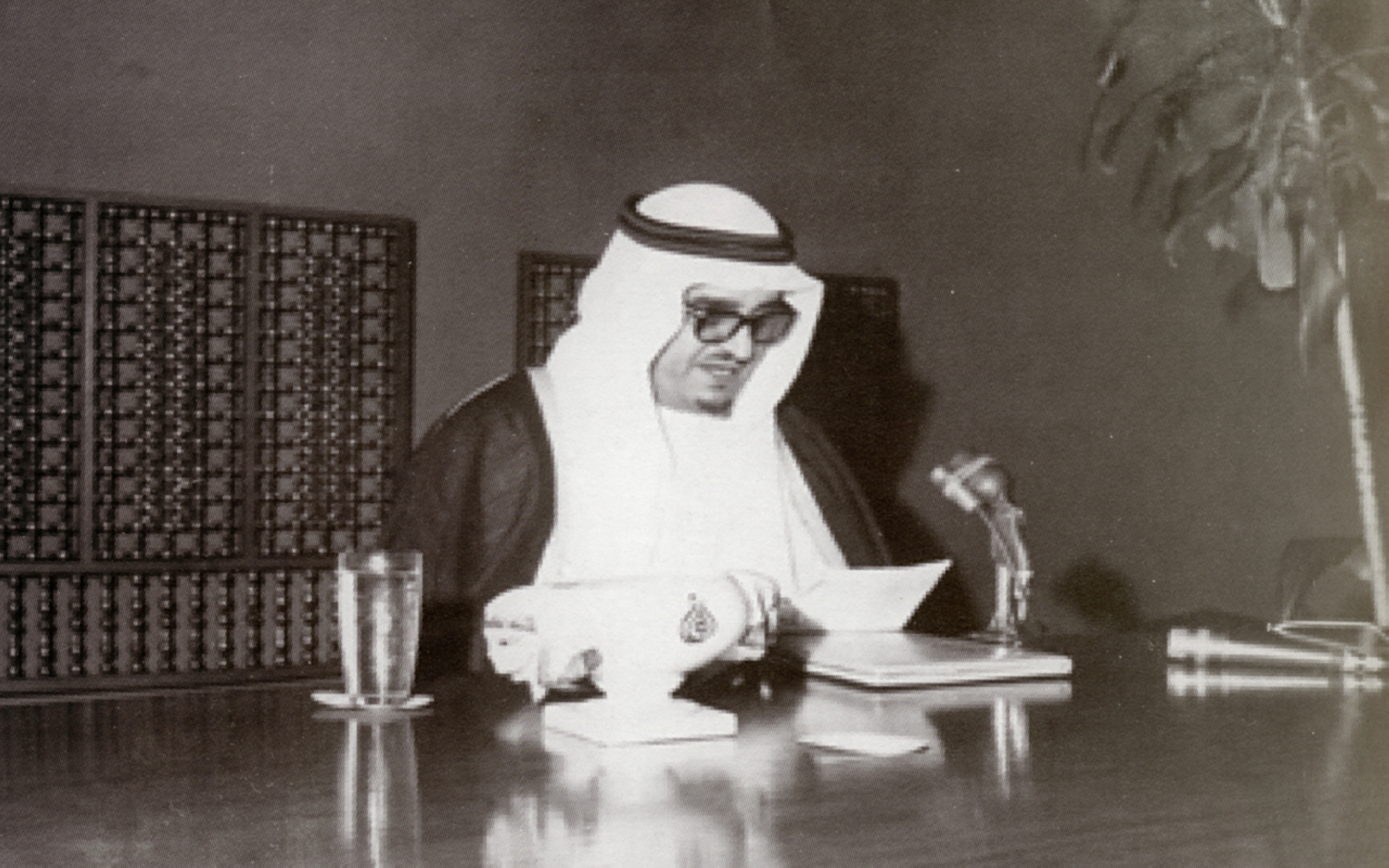
King Fahd in his youth
From his early childhood and youth, King Fahd Bin Abdulaziz showed a passion for the traditions inherited in the large Saudi family. He was particularly fond of equestrian sport, loved horses, and was keen on caring for them and setting up stables. Whenever he heard of a purebred horse, he would attempt to purchase it, offering its owner any price requested in exchange. He began horse riding at a young age and would participate with his brothers and uncles in the races held periodically in the presence of his father, the Founding King, at the old racetrack. This racetrack was situated directly behind the eastern gates of Riyadh. Among his hobbies in his youth, which he maintained even after assuming official positions, were road trips. He would go on these trips with friends and close associates, especially during the spring season. The places he was fond of included al-Tanhat, as-Summan, and Umm Ruqaybah.
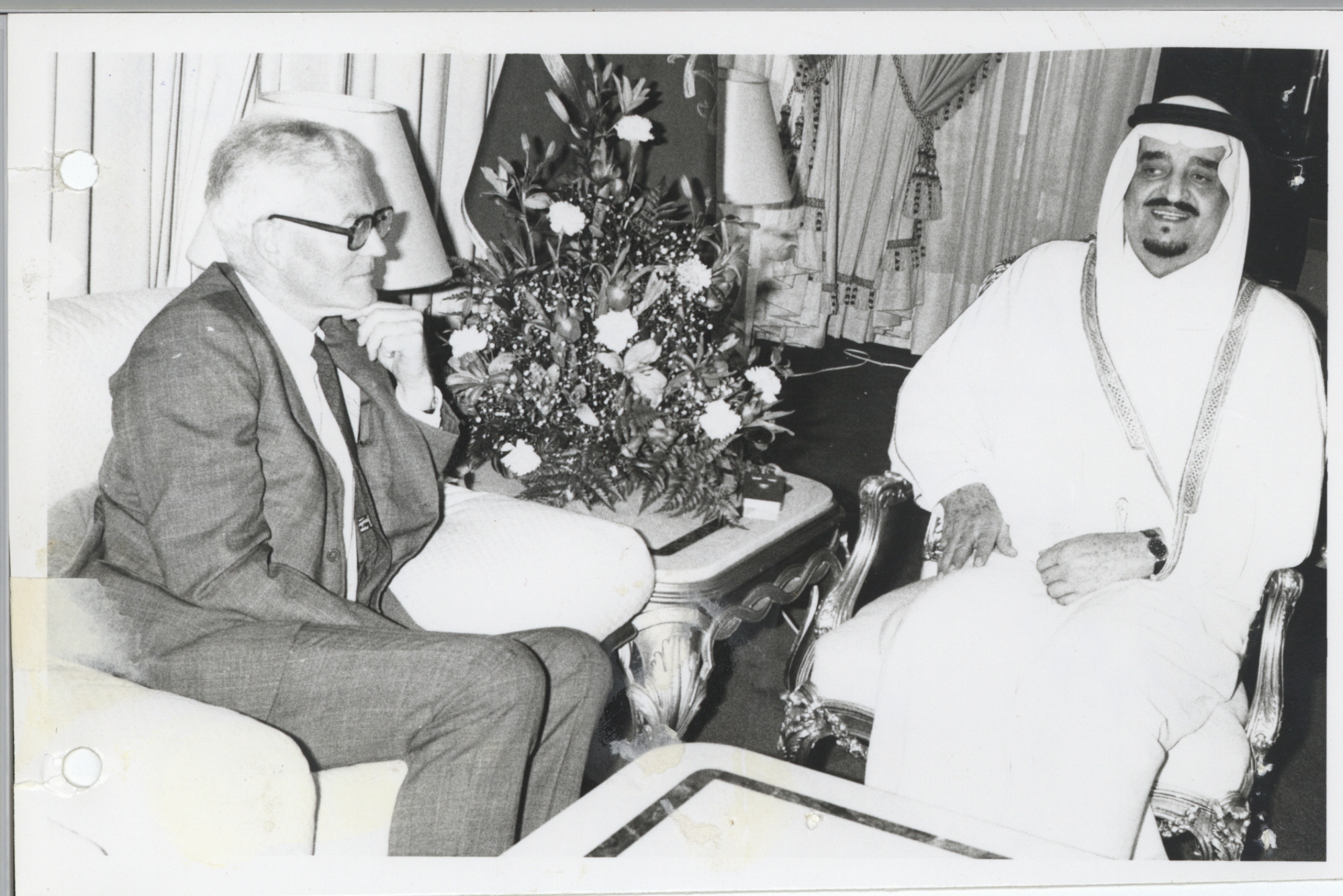
The first mandates and positions of King Fahd Bin Abdulaziz:
Diplomatic mandates and actions
King Abdulaziz entrusted his son, King Fahd, with early official responsibilities in his youth, the first of which came when he was just twenty-four years old. He continued to be assigned mandates by his brothers, King Saud, King Faisal, and King Khalid. Among these mandates were:
On June 26, 1945, he became a member of the Saudi delegation, led by Prince Faisal Bin Abdulaziz, to the first conference of the United Nations and signed the United Nations Charter in San Francisco, United States.
On January 13, 1946, he accompanied his father during his visit to Egypt, where King Farouk bestowed upon him the Grand Cordon of the Order of the Nile.
In 1950, upon the death of King Abdullah Bin al-Hussein, the king of the Kingdom of Jordan, King Abdulaziz sent him as his representative to attend the funeral prayer and participate in the condolence ceremony along with the heads of the Arab delegations who took part in the burial and to offer condolences to his family.
In 1952, his father, King Abdulaziz, sent him to represent Saudi Arabia at the coronation ceremony of the Queen of the United Kingdom. In the same year, he accompanied the Lebanese President, Camille Chamoun, during his visit to Saudi Arabia.
On January 15, 1955, he participated in the ninth session of the Cultural Conference of the League of Arab States, opened the meeting held in Jeddah, and led the Saudi delegation to Yemen in April of the same year.
On August 31, 1959, he led Saudi Arabia's delegation at the meeting of the Council of the League of Arab States in Casablanca.
On August 23, 1960, he headed the Saudi delegation participating in the meetings of the Conference of Arab Foreign Ministers.
On January 8, 1965, he led the Saudi delegation at the conference of the prime ministers of Arab states held at the Arab League in Cairo, and in April of the same year, he headed the Saudi delegation at the Islamic Conference held in Makkah al-Mukarramah.
On May 27, 1965, he led the Saudi delegation participating in the second session of the conference of Arab states' prime ministers held in Cairo.
On October 5, 1967, he led the Saudi Arabia's delegation on a visit to France with the aim of strengthening Saudi-French relations.
On June 29, 1968, he headed the Saudi delegation on a visit to Somalia.
On July 29, 1968, he led the Saudi delegation on its visit to Turkey, and the Saudi delegation on a visit to Lebanon on August 3 of the same year.
On October 9, 1969, he led the Saudi delegation to Britain, and in the same year, he headed the Saudi delegation to the United States on October 13. He also led the Saudi delegation back to Britain to participate in talks regarding the future of the Arabian Gulf region following Britain's withdrawal.
On July 20, 1970, he led the Saudi delegation in the Saudi-Yemeni talks in Jeddah, and the Saudi delegation in the Saudi-British talks in London on December 5 of the same year.
On June 20, 1971, the Islamic Solidarity Charter Conference was opened.
On January 18, 1974, he led the Saudi delegation to Libya.
On June 4, 1974, he headed the Saudi delegation during its official visit to the United States.
On November 11, 1975, he led the Saudi delegation to the United Arab Emirates.
On December 2, 1975, he headed the Saudi delegation to the Arab Republic of Egypt.
On November 25, 1980, he led the Saudi delegation at the eleventh Arab Summit Conference in Jordan.
Leading the educational renaissance in Saudi Arabia
The Ministry of Knowledge (currently known as the Ministry of Education) was established during the reign of King Saud Bin Abdulaziz, and King Fahd, who was then a prince, was appointed as its minister on December 24, 1953. This made him the first Minister of Knowledge in the history of Saudi Arabia, where previously a government department called the 'Directorate of Knowledge' oversaw educational affairs. Since his appointment as minister, the education sector witnessed a comprehensive educational renaissance. He began with systematic planning for the education infrastructure and established the first Saudi university, King Saud University, in 1957. King Fahd is considered a pioneer of the organized educational journey in Saudi Arabia.
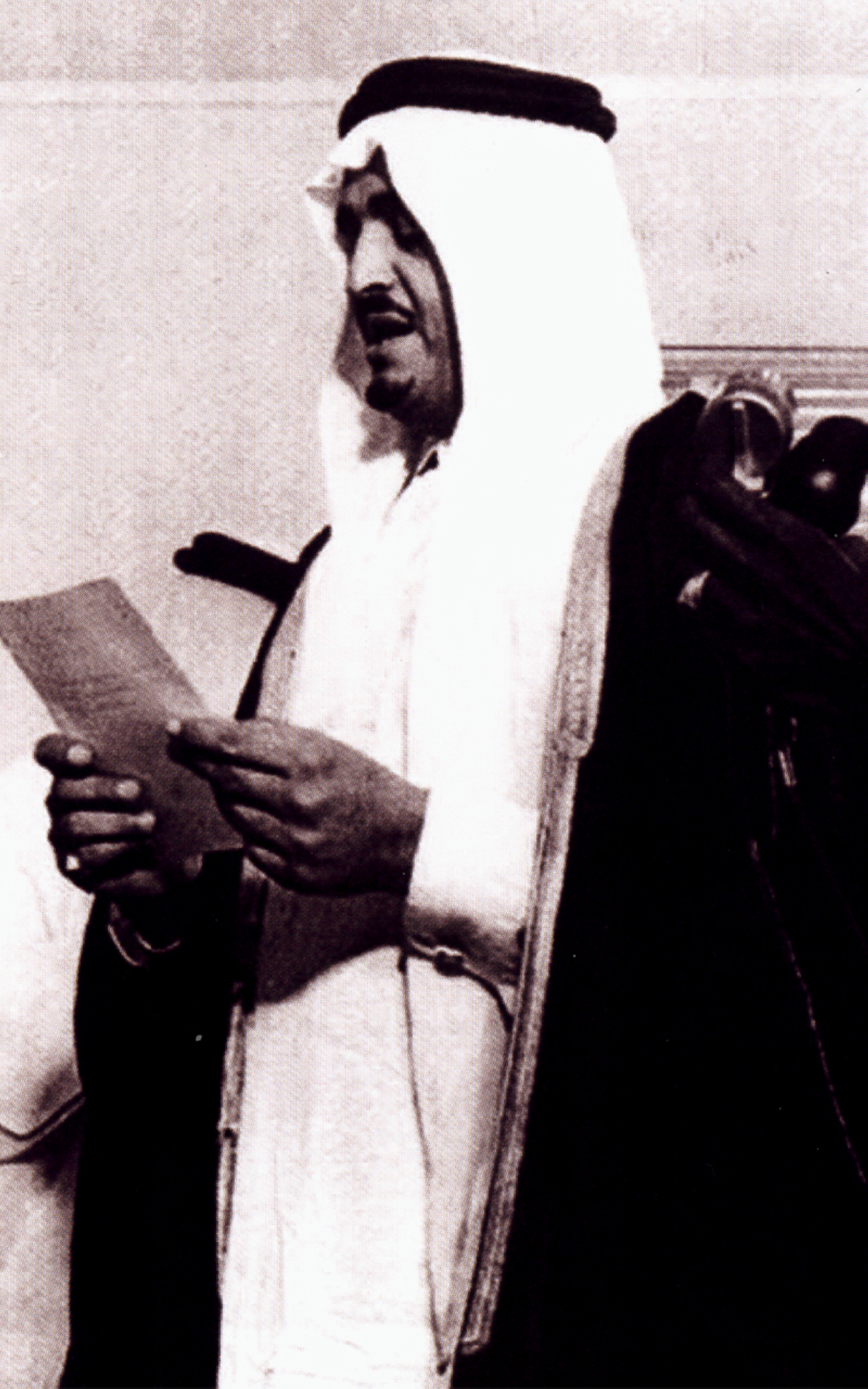
Ministry of Interior
King Fahd was appointed Minister of Interior on October 31, 1962. Upon taking charge of the ministry, he reorganized it comprehensively in line with the developmental strides Saudi Arabia had made across various fields. He paid special attention to the Internal Security Forces College, which became known as 'King Fahd Security College', and established a number of specialized institutes, marking a significant step in the developmental history of the Ministry of Interior.
The second deputy to King Faisal Bin Abdulaziz
During the reign of King Faisal Bin Abdulaziz, King Fahd, who was then a prince, was appointed as the Second Deputy Prime Minister, in addition to his role in the Ministry of Interior, on October 1, 1967.
Crown prince designation
King Khalid Bin Abdulaziz chose King Fahd, who was then a prince, to be the Crown Prince on March 25, 1975. At that time, his responsibilities included the presidency of a number of significant councils and bodies in Saudi Arabia, such as: the Supreme Council for Petroleum and Minerals, the Supreme Council of Universities, the Royal Commission for Jubail and Yanbu, the Higher Committee for Education Policy, the Supreme Council for Youth Welfare, the Higher Committee for Hajj Affairs, the Royal Commission for the Development of al-Madinah al-Munawwarah, and the Higher Committee for Administrative Reform.
King Fahd as King of Saudi Arabia:
Assuming the rule of Saudi Arabia
Following the death of King Khalid Bin Abdulaziz, King Fahd was pledged allegiance as King of Saudi Arabia on June 13, 1982. His reign marked a new phase in the building of the Saudi state, a phase of renaissance and prosperity in all fields: social, administrative, economic, scientific, cultural, and religious.
King Fahd began his reign with a visit to the Grand Mosque and performing Tawaf. Stemming from his desire to serve the Two Holy Mosques, his historic decision was to renounce all titles and choose 'Custodian of the Two Holy Mosques' as his title. This decision was officially announced in the speech he delivered at the opening ceremony of al-Madinah TV station on October 27, 1986, in which he requested the replacement of the title 'His Majesty' with 'Custodian of the Two Holy Mosques'. King Fahd is considered the first to officially adopt the title 'Custodian of the Two Holy Mosques' in Saudi governance throughout its three stages.
King Fahd initiated a new foundational phase for Saudi Arabia, making constitutional changes and issuing four laws that formed the basis of the state's domestic policy. On March 2, 1992, he issued three laws: the Basic Law of Governance, the Shura Council Law, and the Law of Provinces. This was followed by the issuance of the Law of the Council of Ministers on August 20, 1993.
Organizing the state's foreign policy
After assuming power, King Fahd outlined the principles upon which Saudi Arabia's domestic and foreign policies are based, elucidating the key foundations in a speech he delivered on July 23, 1982. One of the most prominent features of King Fahd's foreign policy was its firm and moderate approach, characterized by steadfast adherence to principles and constants without deviation, extremism, or compromise. He emphasized diplomatic methods, avoided sensationalism and slogans, and courageously announced political steps based on the principles upon which his policy was built. This approach earned Saudi Arabia a prestigious international position, founded on the belief in global peace built on justice and fairness.
Saudi Arabia's policy refused to resort to force as an executive tool, and at the same time, it called for belief in the right of self-defense in order to preserve the supreme interests, and reliance on dialogue and negotiations to achieve goals, and opposition to the policy of blocs and military alliances or siding with any party of the parties competing for influence in the world, and pursuing a policy of good neighborliness, and non-interference in the internal affairs of any country. On the other hand, Saudi Arabia categorically rejects any external interference in its affairs and opposes foreign intervention in the affairs and destinies of nations in all its forms. It also seeks to serve Islam and Muslims worldwide, adhering to a gradual yet firm and deterrent strategic policy against any transgression.
The development journey during King Fahd's reign:
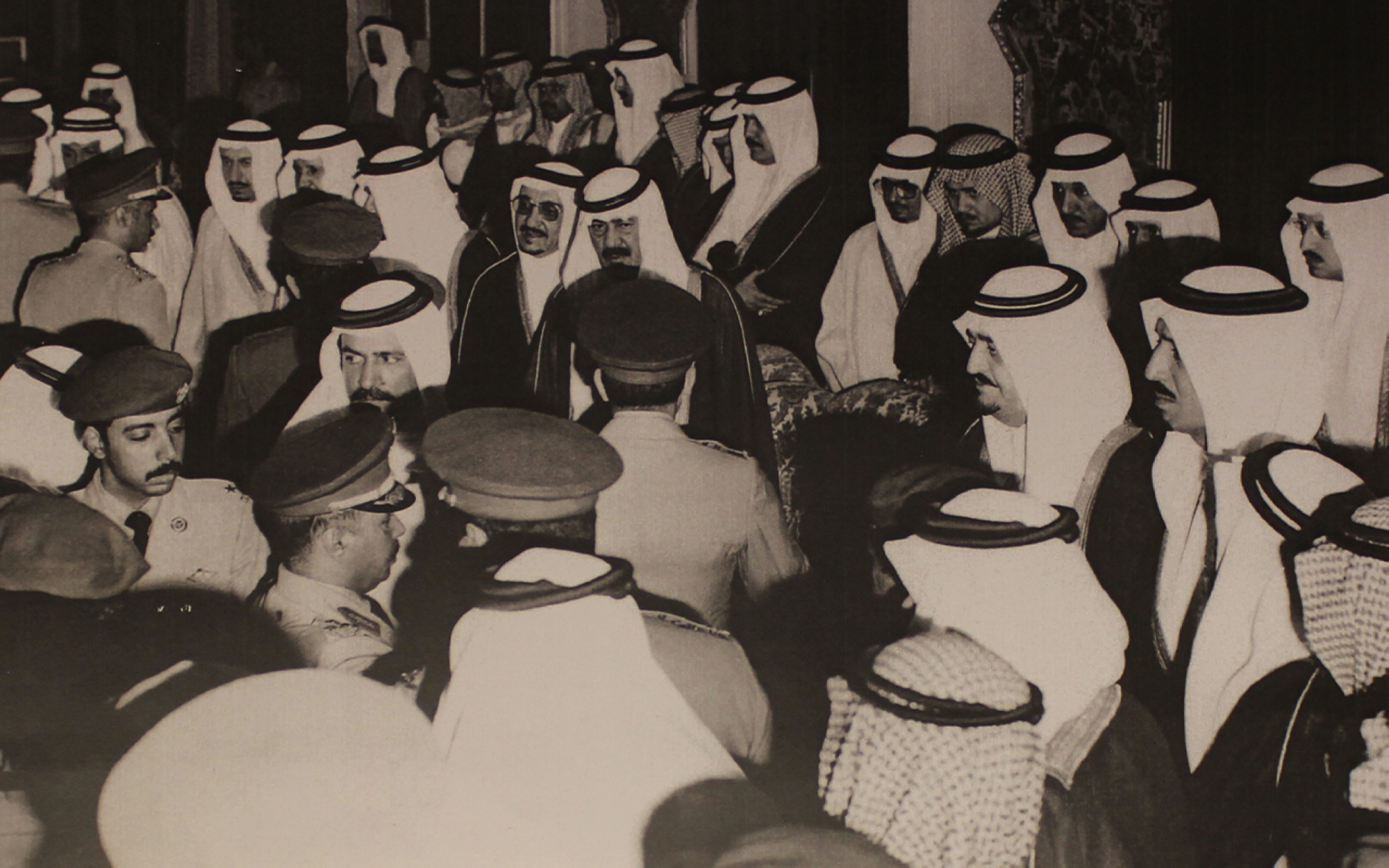
Establishing infrastructure and implementing development plans
When King Fahd, then prince, oversaw the implementation of the Second Development Plan in 1975, as the crown prince during the reign of King Khalid. He supervised the establishment of a complete infrastructure aimed at accelerating development and connecting the various regions of the country with the most efficient and modern transportation networks in the world. After assuming the rule, King Fahd continued the infrastructure projects initiated during the reign of King Khalid. These projects included the development of cities and villages through comprehensive plans, the construction of roads, bridges, tunnels, and communication networks, as well as the expansion of desalination plants. In addition to developing agriculture, improving employees' conditions, establishing new salary regulations, expanding ports and airports, and increasing the establishment of universities and schools. During his reign, the King Fahd Causeway, linking Saudi Arabia and the Kingdom of Bahrain across the Arabian Gulf, was established. It was officially inaugurated in 1986 by King Fahd and Sheikh Isa Bin Salman Al Khalifa.
Development plans persisted while adjustments were made to the economy in accordance with the evolving circumstances, including the plan aimed at diversifying local income sources to reduce dependence solely on oil, the prices of which were starting to decrease. Saudi Arabia bore a lot to stabilize the global oil markets. King Fahd's government was keen on diversifying the economic base. Non-oil gross domestic product (GDP) during that period increased more than fivefold. The average annual growth rate of value added in manufacturing industries reached 8 percent. Agricultural production also increased about fivefold in terms of value-added, reflecting the government's commitment to achieving a suitable level of domestic food production. Moreover, there was an emphasis on strengthening the role of the private sector. Private sector GDP grew at an average rate of about 5.8 percent during King Fahd's reign. Annual private sector investment increased from SAR5 billion in 1981 to SAR64.2 billion in 1999.
During King Fahd's reign, the state achieved a significant increase in the standard of living for citizens. Lands were allocated to families and university students. Urbanization expanded, and many houses were built during his reign. The state provided citizens with facilities in loans and assistance. Industrial cities and modern factories were established in several regions of Saudi Arabia, along with commercial facilitation to provide products, services, and employment opportunities.
A qualitative leap in the Saudi economy
One of the economic achievements during King Fahd's reign was the realization of the strategic objectives of the industrial sector within the Fifth Development Plans, most notably the plan to diversify the economic structure and reduce dependence on crude oil as the sole source of income at that time. Considering that industry is the future choice compared to other alternatives, the Saudi government, in 1980, focused on providing a range of incentives and support for the national industry. Additionally, it established specific industrial projects, especially in sectors where Saudi Arabia excels, such as petrochemical industries, where raw materials are readily available. All facilities and resources were provided to the private sector to assist it in revitalizing and playing its role in the industrial development process. The industrial policy of Saudi Arabia during that period was based on several key pillars: protecting national industries, establishing heavy basic industries, developing petrochemical industries, focusing on other manufacturing industries, establishing industrial cities, attracting foreign capital investment, providing industrial loans, supporting industrial workforce training, granting exemptions and customs protection, and encouraging domestic exports.
The industrial development strategy aimed to develop and capitalize on local resources, whether human, natural, or financial, and increase the contribution of industrial output to the GDP while gradually reducing dependence on the oil sector. It also aimed to increase the capacity of the local market to generate investment opportunities, maximize the value-added of natural resources, especially oil and natural gas, by establishing various manufacturing stages to benefit from these resources, develop technological capabilities of the national economy, grow the industrial sector, increase its contribution to GDP, and diversify national income sources.
As a result of these objectives and the pursued policy, Saudi Arabia achieved a significant leap in the field of manufacturing, as evidenced by statistics on the scale of achievement in the industrial sector. Industrial investments reached around SAR9.1 billion in 2006, with industrial output reaching SAR80 billion in the same year. The value of industrial exports amounted to SAR25 billion, including products from SABIC in the petrochemical industries. Additionally, the number of factories reached 3,306 factories in 2007.
Organizing military and security affairs
Since assuming the rule, King Fahd showed great interest in developing the armed forces system in terms of equipment and armament, scientifically and technically, marking the beginning of the actual development of the Saudi Armed Forces across all its sectors during his reign. This development is manifested in the reorganization of the Ministry of Defense and Aviation, as well as the leadership of the General Staff Presidency. New commands were established for the army, air force, navy, and air defense, each with independent budgets allocated to ensure their continued progress and implementation of their plans. Additionally, efforts were made to rebuild the armed forces by expanding colleges, institutes, schools, and new military training centers to accommodate a larger number of recruits and educated youth from various regions of Saudi Arabia. Military missions were also sent to join advanced military colleges and schools in the United Kingdom, France, the United States, and elsewhere.
Additionally, the construction of military cities, air and naval bases, and air defense groups began, along with the establishment of buildings for college projects and medical complexes housing leadership, housing, public facilities, and services such as schools, mosques, and advanced health centers. Military and vocational training centers were also built, along with the construction of the headquarters of the Ministry of Defense and Aviation and the National Defense Operations Center. These efforts had a significant impact on enhancing the readiness and military capabilities of the armed forces. Major military hospitals were built in major cities, equipped with advanced medical equipment, operated, and maintained. Medical and technical training for Saudis was conducted to provide medical services to members of the armed forces and their families. An air medical evacuation fleet was established and operated by Saudi expertise. Additionally, a medical academy was established in the medical complex in King Fahd Military City. Health centers were opened in camps, residential complexes, and advanced field hospitals.
During King Fahd's reign, new defense systems were built, such as the command and control system and the National Defense Center, as well as command and control centers for branches of the armed forces. Additionally, financial, administrative, and supply information systems were established, collectively forming an advanced defense system. The adoption of the Economic Offset Program with arms-exporting countries and defense systems, allocating 35 percent of the value of arms contracts and defense projects in Saudi Arabia for advanced industrial projects in partnership with the Saudi private sector and the General Authority for Military Industries, was a significant step. This was an advanced move in transferring high technology that few countries had achieved before. It expanded the industrial base of military factories and transformed them into a public institution for military industries to enable them to participate with the private sector in joint manufacturing.
Furthermore, he launched the establishment of a centralized administration for military works and departments in the branches of the armed forces for operation, maintenance, and management of military cities, air and naval bases and facilities, and air defense, managed by qualified Saudi professionals at the highest engineering levels and management, operation, and maintenance systems. Additionally, he established the General Directorate of Military Survey tasked with drawing military aerial and naval maps, coordinating with the state's surveying administration, and training its employees. Specialized departments were established to enhance the religious and moral aspects of Saudi soldiers in the armed forces, such as the Department of Religious Affairs for the Armed Forces, along with the creation of an administration for retirees' affairs to address the needs of officers and military personnel upon retirement, and to provide them with necessary services post-retirement.
Educational renaissance
During the reign of King Fahd Bin Abdulaziz, education witnessed special attention as it was considered the cornerstone for building both the citizen and the nation. The care for the education sector continued through Saudi Arabia's five-year development plans, resulting in a total of more than 5.3 million male and female students across various stages of general and higher education by 2003-2004. They were taught by approximately 440,000 male and female teachers.
The number of students enrolled in the Ministry of Education in 2004 exceeded 2,539,188 students, supervised by 196,019 teachers, distributed across 14,612 schools. Meanwhile, the number of female students in various stages of education reached 2,311,467, taught by approximately 220,000 female teachers in 15,800 educational institutions. Saudi Arabia's universities included eleven colleges for male and female teacher preparation, technical, and health colleges totaling 317, with 455,000 male and female students taught by around twenty-three thousand faculty members.

Sport aspect
During the reign of King Fahd Bin Abdulaziz, the Saudi national team qualified for the FIFA World Cup three consecutive times in 1994, 1998, and 2002. It also won the AFC Asian Cup three times in 1984, 1988, and 1996. It claimed the Arab Cup twice in 1998 and 2002. Meanwhile, the national team won the Arabian Gulf Cup three times in 1994, 2002, and 2003. As for the Saudi U-20 national team, it participated in the FIFA U-20 World Cup in the following years: 1985, 1987, 1989, 1993, 1999, and 2003. The team won the AFC U-19 Asian Cup twice, in 1986 and 1992. It secured the Arab Youth Cup in 1985.
The Saudi U-17 national football team won the FIFA U-17 World Cup in 1989, following three appearances in 1985, 1987, and 1989. The team also won the AFC U-16 Asian Cup twice, in 1985 and 1988. In other sports, Saudi Arabia achieved its first Olympic silver medal in 2000 through international sprinter Hadi Soua'an at the Sydney Olympics.
Historical achievements of Saudi Arabia during the reign of King Fahd:
Strengthening Islamic solidarity and Arab unity
King Fahd supported Arab and Islamic causes, driven by Saudi Arabia's responsibility rooted in its creed and history towards Arabs and Muslims. Among the most prominent of these causes is the Palestinian cause. Support took various forms, including media support, where all visual, auditory, and print media were utilized to endorse the Palestinian cause and clarify the Palestinian right to the land. Additionally, there was financial support through committees formed in various regions of Saudi Arabia to collect donations. Educational and academic support was also provided by facilitating educational opportunities for Palestinian residents' children at all levels of education. Furthermore, there was health support, religious and social services, and political support, culminating in King Fahd's peace initiative presented in August 1981, and endorsed at the twelfth Arab League Summit in Morocco in 1982.
He also supported the cause of Bosnia and Herzegovina in its attempt for independence and its war with the Republic of Serbia, where Saudi Arabia was the first country in the world to officially recognize the independence and sovereignty of Bosnia and Herzegovina in 1992, and this was a motive for its recognition by other Islamic countries, and the declaration of standing with the Bosnian people through material and humanitarian aid. King Fahd also supported the cause of the Muslims in the Kosovo region against the Republic of Serbia, where he initiated the formation of the Saudi Joint Committee for the Relief of Kosovo. This included establishing an airlift to provide food and health needs, setting up camps, sponsoring orphans, creating a field hospital, health centers, and supplying them with ambulances, medicines, and medical supplies, and adopting educational and advocacy programs. After the war ended, the relief committee took responsibility for creating a plan for the return of the refugees and the reconstruction of mosques, homes, bridges, cultural centers, and schools.
King Fahd played a prominent role in relieving the state of Somalia and alleviating the humanitarian tragedy following the civil war that had expanded at the time and caused a lot of damage to the Somali people. Under the leadership of King Fahd, Saudi Arabia participated in the Somali Reconciliation Conference in Djibouti in 1991, then hosted its concluding sessions in Saudi Arabia. He also supported international and regional organizations and authorities to enable them to play their role in solving the Somali problem, in addition to implementing relief programs and supporting educational, social, and developmental programs and projects. King Fahd also played a role in ending the civil war in Lebanon, where the Taif Conference was held on September 30, 1989, between the conflicting forces, and the National Reconciliation Accord was signed, which ended the conflict in Lebanon.
During the reign of King Fahd, Saudi Arabia helped the state of Afghanistan liberate its territory from Soviet occupation (formerly the Soviet Union), where it was the first country to recognize the independence of Afghanistan in 1989. After the withdrawal of Soviet forces, King Fahd contributed to stopping the internal conflict between the Afghan forces and achieving reconciliation among them. He invited them to a meeting in Makkah al-Mukarramah on March 11, 1993, where a peace and reconciliation agreement was signed. In addition to this, Saudi Arabia supported the Afghan people financially, morally, socially, and health-wise through the construction of mosques and schools, and sponsoring orphans. King Fahd also supported the Muslims of Chechnya and urged the international community to start negotiations and end the crisis there, in addition to providing material and moral support on all levels. The contributions and support of King Fahd to Islamic causes were not limited to countries alone but also extended to all Muslim minorities around the world. This support included advocating for their political rights, providing intellectual and educational support, facilitating minority delegations to perform Hajj and Umrah, and supplying them with copies of the Holy Quran and translations of its meanings, in addition to the financial donations provided by Saudi Arabia.
Gulf cooperation
King Fahd Bin Abdulaziz's name became prominent in the liberation of the State of Kuwait, after the invasion by Iraqi forces at dawn on August 2, 1990, due to a border dispute between the two countries. King Fahd played a heroic role in freeing Kuwait from the invasion and restoring security and stability to it. Saudi Arabia began its efforts immediately after the aggression on Kuwait was declared, starting with diplomatic movements and peace efforts, initially through the Arab League to contain the crisis from its outset. After the delay in Arab action, Saudi Arabia turned to the international arena and the Security Council, resulting in the issuance of twelve resolutions related to the Gulf crisis, which expressed a collective will to liberate Kuwait in affirmation of the principle of international legitimacy. Among these, Resolution 678 in November 1990, which authorized the use of military force, was the most significant.
Saudi Arabia succeeded in obtaining the support of the Arab Summit held in Cairo in 1990 for the deployment of military forces from Egypt, Syria, and Morocco. Saudi Arabia also sought the participation of Islamic forces from Pakistan, Bangladesh, and Afghanistan. Then, King Fahd made a historic decision to allow the entry of international coalition forces into Saudi Arabia with the aim of repelling the aggression and liberating Kuwait, restoring Kuwait's legitimate government, and achieving security and stability in the Gulf region. Operation 'Desert Storm' was launched on January 17, 1991, and lasted for forty-two days, during which the joint forces managed to liberate Kuwaiti territory and restore the country's legitimate government.
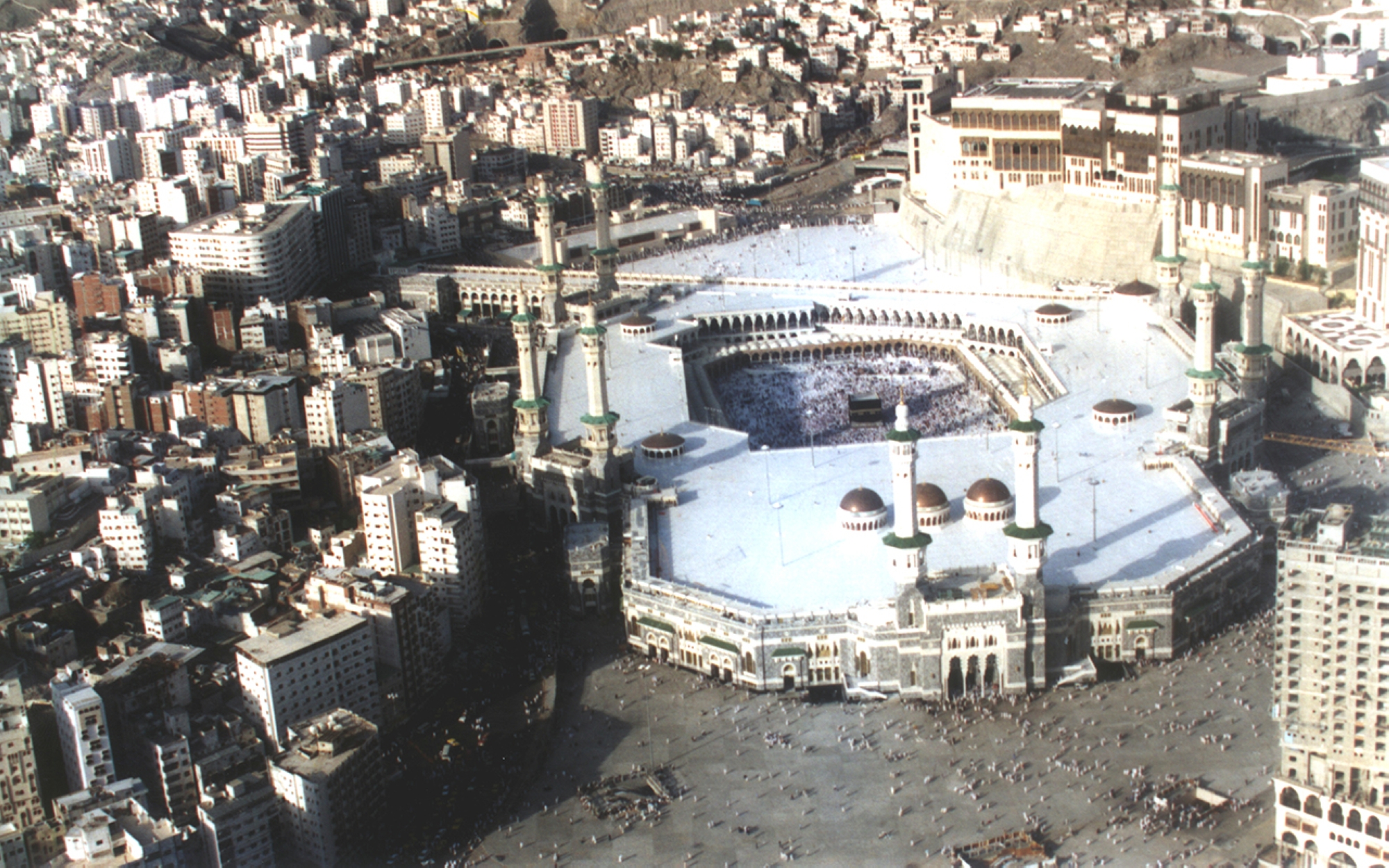
The grand expansion of the Two Holy Mosques
Since his allegiance as the King of Saudi Arabia, King Fahd Bin Abdulaziz was keen on providing care for the pilgrims of the Grand Mosque and visitors to the Prophet's Mosque. He visited al-Madinah al-Munawwarah in October 1982 and ordered a study for a major expansion of the Prophet's Mosque to accommodate as many worshippers as possible. On Friday, November 2, 1984, King Fahd laid the foundation stone for this expansion. Work on this project began on September 20, 1985, with an executive committee formed under the presidency of the then Governor of al-Madinah al-Munawwarah, Prince Abdulmajeed Bin Abdulaziz, to oversee and follow up on the project. The first steps of implementation began with the expropriation of properties, and committees were formed to evaluate them and compensate their owners, followed by their removal. By the middle of 1990, the infrastructure had been completed, and King Fahd's directive was that the expansion be carried out at the highest level, with record speed, and that all required services be provided for the Hajj and Umrah pilgrims while ensuring their safety from any harm during the construction works of this expansion. In the Hajj season of 1992, most parts of the expansion were opened to worshippers, and in the following year, the roof of the expansion was equipped for prayer.
The Prophet's Mosque expansion project consists of the expansion building, its roof, and a number of plazas, with a total area of 400,500 m, accommodating more than a million worshippers during peak times. The expansion building includes a basement with the same area as the ground floor of the expansion, designated for air conditioning and cooling devices and other services. The building is equipped with twenty-seven mobile domes, each with a diameter of eighteen m, covering an area of 323 m². These domes can slide on rail tracks installed above the expansion's roof, operating via remote control. The expansion included seven main entrances on the northern, eastern, and western sides, with each main entrance containing five adjacent doors, in addition to two side gates. There are two main entrances on the southern side of the expansion, each containing three adjacent doors, plus ten side doors and twelve gates for the escalators leading to the expansion's roof. The total number of external wooden doors for the expansion is 142, including sixty-five large doors. There are also eighteen staircases and six buildings for escalators containing twenty-four escalators. In the center of the northern side of the expansion, there is the 'King Fahd Bin Abdulaziz' entrance, which is the main entrance to the expansion, topped by seven domes. On each side of this entrance, there is a minaret with a height of 105 m. The total number of minarets in the Prophet's Mosque, including the expansion, is ten, six of which are new. The minarets are distributed over the four corners of the expansion, with two minarets on either side of the main entrance.
Regarding the Grand Mosque, King Fahd ordered in 1986 that the surface of the first Saudi expansion be tiled with cool marble resistant to heat to prepare it for worshippers. The electrical networks spread throughout it were obstructing worshippers, so King Fahd ordered that all electrical networks be consolidated into beautifully shaped domes The surface area reached 61,000 m, accommodating ninety thousand worshippers. He also ordered the installation of five escalators in the Grand Mosque to facilitate ascending and descending to the roof and the first floor. Additionally, five overhead bridges were constructed for entry and exit to and from the first floor on the northern side. On September 13, 1988, King Fahd laid the foundation stone to begin the second Saudi expansion, four years after work began on the expansion of the Prophet's Mosque, allowing work on both expansions to proceed simultaneously. The King Fahd expansion project is located on the western side of the area which was known as the small market, situated between the Umrah Gate and the King Abdulaziz Gate. The expansion building consists of a basement, a ground floor, and a first floor. It was designed and built with a comprehensive air conditioning system in mind. A central air conditioning station was established in the Ajyad neighborhood. In the basements, all necessary elements were installed, including extensions, channels, and openings in the bases of the round columns for the absorption of hot air, as well as openings at the top of the square columns, where cold air and water are pumped into them from the central station.
In the expansion, fourteen doors were added, bringing the total number of doors in the Grand Mosque to 112, some of which include three or four openings. Two buildings for escalators were constructed on its north and south sides, along with two internal staircases, making the total number of escalators in the Grand Mosque nine. This is in addition to the fixed staircases distributed throughout the Grand Mosque building. In 1991, large plazas surrounding the Grand Mosque were equipped for prayer and were paved with cool, heat-resistant marble. Their total area amounts to 88,000 m. In 1994, the expansion of al-Safa area on the first floor began by narrowing the circle of al-Safa opening located under al-Safa dome. In 1996, some buildings around al-Marwah area were removed and incorporated into the expansion, resulting in an area size of 375 m. Additionally, the passageway from al-Marwah side to al-Masaa on the first floor was expanded, and new doors were created on the ground and first floors for entering and exiting from al-Marwah side. In 1997, al-Raqubah Bridge was constructed, linking the roof of the Grand Mosque to al-Raqubah area from al-Marwah side, to facilitate entry and exit to the mosque's roof. Additionally, the passageway adjacent to al-Masaa, which is used for Tawaf on the first floor during crowded times from al-Safa area to the midpoint of al-Masaa, was expanded to a width of nine m and twenty cm and a length of seventy m. In the same year, the cover of Maqam Ibrahim, peace be upon him (PBUH), was renewed with copper covered with gold leaf, crystal, and decorated glass, and a cover made of strong, heat-resistant, and shatterproof crystal glass was placed over Maqam Ibrahim (PBUH).

King Fahd Glorious Quran Printing Complex
King Fahd saw the need of the Islamic world for the Holy Quran and for translations of its meanings into various languages, as well as the importance of caring for its sciences. Sensing his role in serving Islam and Muslims, and the significance of serving the Holy Quran through a specialized and dedicated entity for this noble task, he laid the foundation stone for the King Fahd Glorious Quran Printing Complex in al-Madinah al-Munawwarah on November 2, 1982. It was officially inaugurated on October 30, 1984. The supervision of the complex is undertaken by the Ministry of Islamic Affairs, Dawah, and Guidance, with the Minister of Islamic Affairs, Dawah, and Guidance serving as the general supervisor of the complex and the president of its supreme authority. The implementation of the complex's policies and the achievement of its goals are followed up by a general secretariat, led by the complex's appointed secretary-general.
The complex works on printing the Holy Quran according to the authenticated narrations in the Islamic world, recording the recitation of the Holy Quran in the famous narrations in the Islamic world, translating and printing the meanings of the Holy Quran and its interpretation into the most important and widely spoken languages, and caring for the sciences of the Holy Quran and verifying the treasures of the works that serve these sciences. It also focuses on Islamic research and studies related to the Holy Quran and its sciences, meeting the needs of Muslims inside and outside Saudi Arabia through various publications of the complex, and distributing complex publications on global networks, as well as through various programs and applications. The complex covers an area of 250,000 m and is a fully integrated urban unit in its facilities. It includes a mosque, administrative buildings, maintenance, a printing press, warehouses, transportation, marketing, a library, a medical clinic, and other support services. Additionally, it encompasses what pertains to the new warehouse building and the new library for the management of scientific affairs.
Holy sites development
Interest in the holy sites and their development began during the era of the Founding King, but the project of the developed tents in Mina, introduced during the reign of King Fahd, is considered the largest of the holy sites development projects, aimed at providing facilitations to the pilgrims according to the highest safety standards. Saudi Arabia utilized its resources to provide developed tents as part of the Hajj site development. These tents are made from fiberglass fabrics coated with Teflon, resistant to high heat and flame, and do not emit toxic gases. The best modern technologies were used in the manufacturing and implementation phases of these tents. Some are interconnected by passageways, and each group of tents is surrounded by metal fences that include main and emergency doors.
The camp is interspersed with pathways that have been paved, illuminated, and equipped with signposts, with flexibility considered in their parts for shaping and assembly. The dimensions of the standard tent are eight by eight m, and tents of varying sizes ranging from six by eight to twelve by eight m have also been used. The tent project incorporates an air conditioning system and water hoses within the campsites. Each site is equipped with boxes, each containing a hose that is thirty m long. Additionally, fire extinguishers are strategically placed along the pathways inside the camp, with one box available for every one hundred m, to be used if necessary until civil defense arrives.
The tents span an area of 2,500,000 m and can accommodate approximately 2,600,000 pilgrims, making Mina site the largest tent city in the world. The development project for the holy sites is grounded in the principles of security, safety, and environmental suitability. The tents are equipped with air conditioning, in addition to being resistant to climatic factors, designed to conform to the Islamic aesthetic, and constructed with flexible components for easy shaping and assembly. Toilets and ablution facilities were provided within the camp, along with electrical power distribution equipment, kitchens, and waste disposal areas. Each tent is equipped with water sprinklers that activate automatically upon detecting heat. As soon as water is emitted from these sprinklers, an alarm sounds in the Mutawwif tent to alert to the danger. Special fire water tanks are available in the form of tunnels at the top of the mountains in Mina, with a capacity of two hundred thousand m, feeding the fire extinguishing network with suitable diameters, along with the necessary valves and parts. The total length of this network is one hundred km of pipes, with diameters ranging between 250 mm and seven hundred mm, including eight hundred valves and 740 fire hydrants.
Personality and traits of King Fahd:
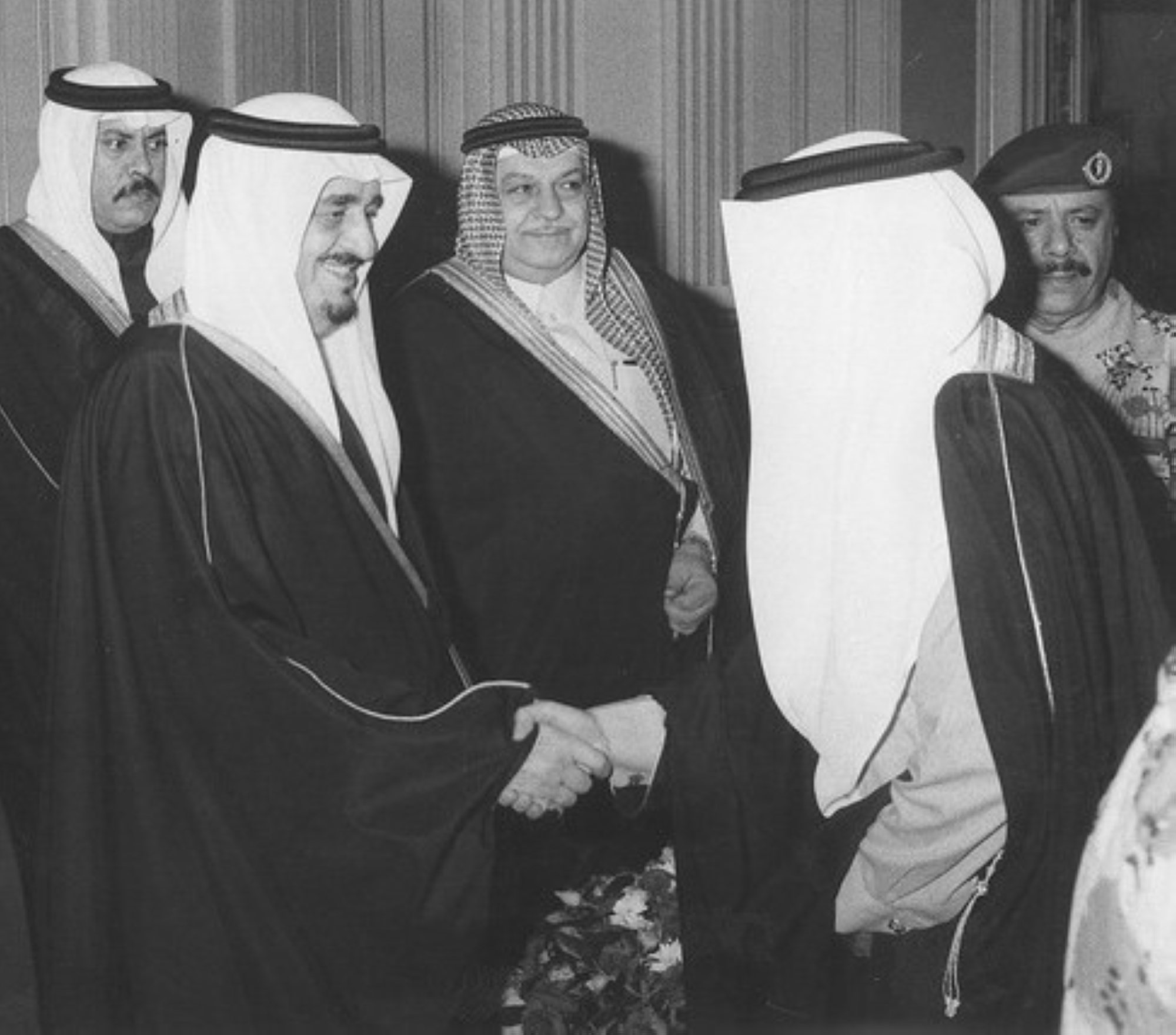
Intellectual and political acumen
King Fahd's personality was distinguished by political acumen based on good treatment, logic, wise and mature leadership, crisis management, political experience, making timely decisions, communicating with people according to their levels, observing norms, traditions, and dialects, not basing political stances on impulsiveness and reaction, patience in the face of harm, maintaining principles, tolerance, and broad-mindedness even with opponents. King Fahd's reign witnessed many regional and international challenges, concurrent with the rapid changes and disturbances the world experienced. King Fahd was able to confront and deal with these through his political experience and diplomatic acumen. Alongside wisdom in foreign policy and the ability to confront adversities and challenges, King Fahd's reign was characterized by diligent work toward achieving global peace based on truth, justice, and equality, and exerting efforts to serve Arab and Islamic solidarity. He also focused on providing aid and assistance to those in need around the world.
King Fahd was a top-tier statesman, a talented and astute politician, a leader in his country's development journey, a pioneering voice for Arab and Islamic solidarity, and a moderate international figure working towards achieving peace based on justice for all nations. He had a unique vision of global issues, notable stances on public events, and a distinguished role and prestigious status, having secured a high position among contemporary leaders and those influential in public opinion. During the Second Gulf War, marked by the invasion of Kuwait, he took a firm stand that ended the aggression, demonstrating political acumen and a genuine insight that managed to change the course of events.
Adherence to religion and ethical values
King Fahd derived commendable qualities and virtues from his father's household and its assemblies, brimming with the elite of men. These instilled in him the essence of human interaction experience with those around him, the staff in his service, and with the general populace. King Fahd's history and biography are filled with remarkable humanitarian actions that are too numerous to count. These qualities are clearly reflected in what his children and grandchildren remember about his compassion and fatherly care. He was kind to them and also a teacher, adopting beneficial methods in dealing with the youth. This approach is evident in all his interactions and conversations with the general public. He was firm in situations that required strictness, yet exhibited gentle wisdom and patience whenever circumstances called for kindness and consideration. This attribute was even evident in the difficult situations the country faced, clearly reflecting the humanity of King Fahd Bin Abdulaziz and his commendable qualities.
His treatment was smooth with citizens, both officials and non-officials, and this was evident even with the young children of the country. This was highlighted during his visits to the schools of Saudi Arabia when he took over the first Ministry of Knowledge portfolio at the beginning of its formation. He also showcased his great intelligence in dealing with the younger generation and the ways he conversed with them. He made them feel valued during discussions, emphasizing the importance of the knowledge and sciences they were acquiring in their schools.
Aspects of King Fahd's life:
Family and children
King Fahd married at the age of sixteen and had several sons and daughters, including Faisal, Mohammed, Saud, Sultan, Khalid, al-Anoud, Luluah, Latifah, al-Jawhara, and Abdulaziz.
King Fahd was affectionate, compassionate, and forgiving in raising his children. He was very lenient and cared about the feelings of others. He was also keen on instilling authentic Islamic and Arab values in them, both in behavior and actions. His children witnessed his assistance to the needy and his willingness to help anyone in need, as well as his love for people. They learned from his example and took him as a good role model in these behaviors and good deeds. In the educational aspect, King Fahd was concerned about his children's education and closely followed their progress with care. He guided them to adopt good behavior. He also provided all his children with a lot of care, love, and encouragement to continue seeking knowledge.
He was also keen on religious culture and monitored his children's academic achievements on a daily basis. He would inquire about the subjects they were studying, ensure they completed their school assignments, and listen to feedback from their teachers and school regarding their behavior and adherence to school objectives. He personally followed up on their progress via phone calls or by sending someone to inquire about his children at school. According to King Fahd's children, he used to gather with them to guide them on the importance of knowledge, ethics, and how to interact with others. He emphasized the importance of respecting everyone regardless of their status and not diminishing the value of others regardless of their status. He was keen to instill in them moderation and balance in social interactions.
Death of King Fahd
Announcement of the death of King Fahd
King Fahd Bin Abdulaziz passed away on August 1, 2005. His funeral prayer was held at Imam Turki Mosque in Riyadh City, and he was buried in al-Oud Cemetery in Riyadh, after a reign of a quarter-century as the King of Saudi Arabia. King Abdullah Bin Abdulaziz Al Saud (who was the Crown Prince at the time) succeeded him to the rule.
'Al-Fahd: Spirit of Leadership' exhibition
The King Fahd Charity Foundation organizes an exhibition on the history of King Fahd Bin Abdulaziz, 'Al-Fahd: Spirit of Leadership', offering complete historical documentation of King Fahd Bin Abdulaziz's journey and his achievements on all fronts: local, Gulf, Arab, and international, in addition to his personal life. This documentation is presented in a professional manner that ensures consistency in stages, dates, and content. Furthermore, modern technology tools are used to display the information in an engaging way for visitors. The exhibition is also aimed at the current generations of youth to acquaint them with the biographies of their kings and leaders, the circumstances they lived through, and the achievements they accomplished for their peoples and countries.
Entities named after King Fahd
- King Fahd Causeway Authority.
- King Fahd Sport City in Riyadh.
- King Fahd University of Petroleum and Minerals.
- King Fahd Armed Forces Hospital.
- King Fahd Specialist Hospital in Dammam.
- King Fahd Security College in Riyadh.
- King Fahd Air Base in Taif.
- King Fahd Cultural Center in Riyadh.
- King Fahd Glorious Quran Printing Complex.
- King Fahd Sport City.
- King Fahd International Airport in Dammam.
- King Fahd Industrial Port in al-Jubayl.
- King Fahd's Fountain.
Related quizzes
Related articles


